AIMA Santa Monica Review | Contemporary California Cruising
This hybrid cruiser/commuter e-bike blends responsive pedal assist with a comfortable ride and a robust, user-friendly feature package.

Here at Electric Bike Report, we’re lucky to have a community of smart, trustworthy, and experienced readers and viewers. That’s why we listen when you speak up!
For years, the AIMA Santa Monica has been one of the most requested e-bikes our audience has asked us to review. After such a long time, we were excited to finally get the bike in for testing, and at first glance, it was clear why the bike was so popular.
As a cruiser/commuter hybrid, the Santa Monica is well-equipped for both functionality and comfort. It features an accessible step-thru frame, an accommodating saddle, and swept-back handlebars that keep the rider upright. It also includes wide, stable tires, integrated lights and turn signals, a suspension fork, and an MIK-compatible cargo rack.
The bike was also highly impressive in practice; as with every model we’ve reviewed, we conducted extensive performance tests, but even a short test ride was enough to reveal the Santa Monica’s lively, responsive feel. Its powerful motor delivered assistance smoothly and quietly, making short work of hills and adapting its output to match our pedal effort.
Looks are certainly subjective, but we couldn’t help but dig the Santa Monica’s classic yet refined aesthetic. Our test bike’s glossy cornflower blue color reminded us of an automobile’s paint job, while its brown faux leather saddle/grips and tan-wall tires added a retro vibe to the whole package.
The bike ultimately delivered in looks, ride feel, and on-paper specs, but how did its performance compare with similar cruiser and commuter-style e-bikes we’ve tested? See our full review below to find out!
Class 2 (throttle to 20 mph)
Class 3 (pedal assist to 28 mph)
 Pros
Pros- It’s extremely fun to ride! The Santa Monica feels peppy and highly responsive due to its quiet 750W motor and torque sensor.
- Many of its trim elements feel like a step up from similar e-bikes, such as the MIK-HD cargo rack and control module for the lights, turn signals, and electronic horn.
- The Santa Monica is one of the best hill climbers of its style we’ve tested; see our Hill Test section for details!
- The ride feels extra stable and cushy, thanks to its wider-than-average 27.5×2.6” street tires.
- As expected for a cruiser-style e-bike, it’s remarkably comfortable to ride. The bike’s upright positioning, plush saddle, and faux leather grips felt great!
- Unlike similar models with mobile apps and tons of customization options, the Santa Monica is simple and easy to use with little more than the basics to learn and operate.
- Its fit is customizable, with an adjustable stem and two frame sizes that accommodate riders from 5’1” to 6’3”.
- Looks are undoubtedly subjective, but we loved the contrast of our test bike’s blue paint job, brown saddle and grips, and tan-wall tires.
 Cons
Cons- Riders wanting to access the bike’s higher Class 3 speeds (or go back to Class 2 mode later) must go through dealers for alterations.
- Battery: Removable Internal Lithium-ion 48V, 15Ah (720Wh) with LG M50LT 21700 cells
- Charger: 48V 3 Amp Fast Charger, about 5 Hours to a Full Charge
- Display: Color LCD, Smart Easy-to-Read Display with Backlight
- Motor: 750W, 48V Brushless Rear Hub Motor (1260W Peak), 70 Nm Torque
- Headlight: Integrated LED
- Taillights:Integrated LED with Turn Signals
- Pedal Assist: 5 PAS Levels, Torque Sensor
- Claimed Range: 30 to 60 Miles
- Throttle:Throttle on Demand
- App:N/A
- UL Certification:UL 2849 & UL 2271 Certifications
- Claimed weight: 64 lbs. (Battery included)
- Tested Weight: 70.2 lbs (including 8.7-lb battery)
- Rider height range: 5’1”-5’10” (Regular), 5’6”-6’3” (Large)
- Total payload capacity: 400 lbs.
- Brakes:Tektro Hydraulic Disc Brakes, 203 mm Rotors
- Fenders:Alloy, Included
- Fork:SR Suntour Suspension Fork, 75mm Travel, Lockout, Thru Axle
- Frame: 6061 Single-Butted Aluminum Alloy Frame with Internal Battery
- Drivetrain: Shimano 8 Speed, 52T Chainring, 11-34T Cassette
- Grips: Ergonomic Comfort
- Saddle: AIMA Comfort, 280mm*270mm Saddle
- Handlebar: Aluminum Alloy Double Wall, 31.8mm, 680mm
- Kickstand: Aluminum Alloy Kickstand
- Pedals: 9/16″ Alloy Platform
- Tires: 27.5″ x 2.6″
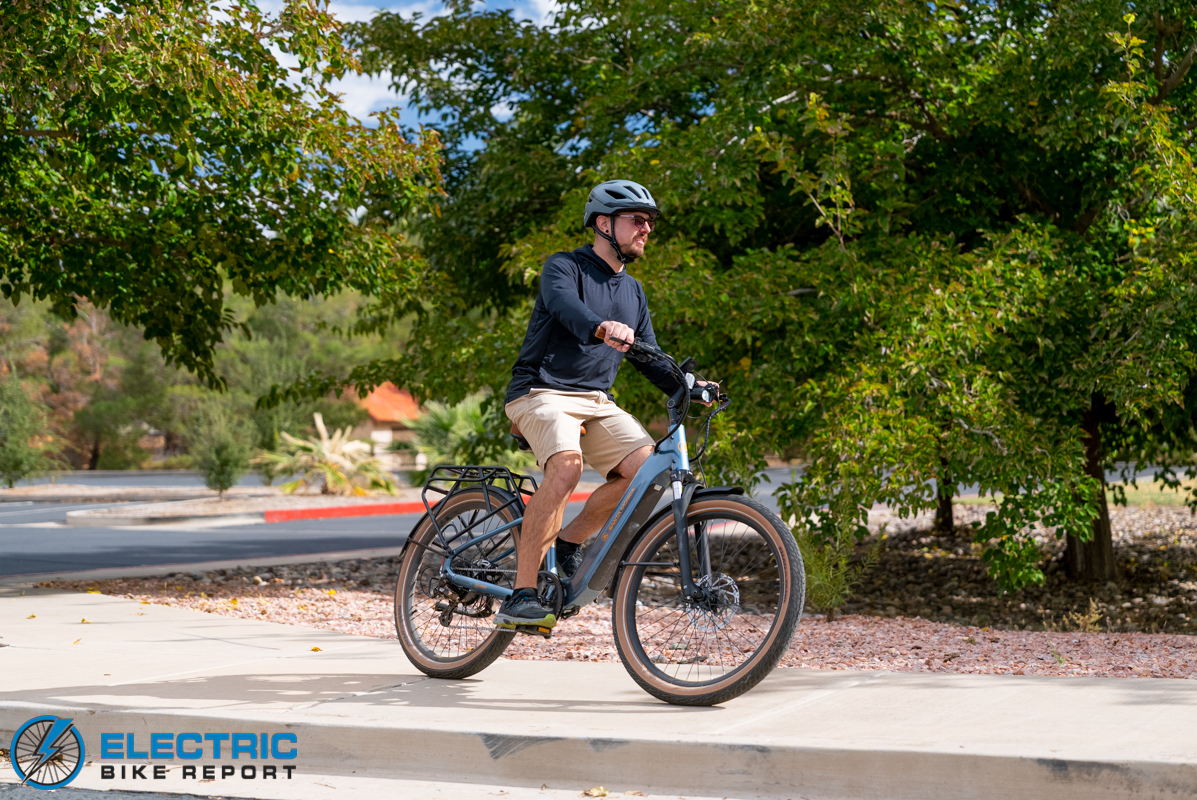
Whether you prefer a casual cruise or a quick commute, the Santa Monica can meet you where you pedal.

The bike’s 750W hub motor is paired with a torque sensor for power that adapts to your effort.
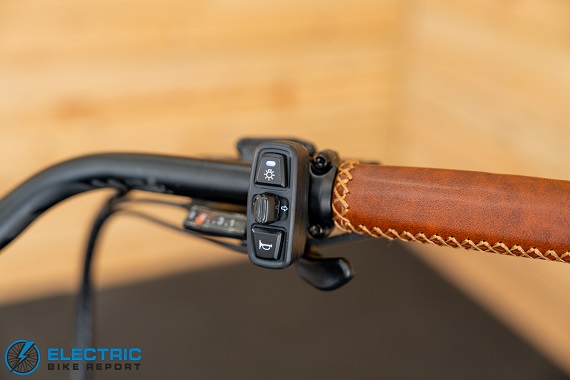
A control module on the left handlebar governs the bike’s lights, turn signals, and electronic horn.
AIMA Santa Monica Review: Speed Test
When the Santa Monica rolls out of an AIMA dealer, its maximum speed will be set to 20 mph by default, though its pedal-assisted speed can be increased to 28 mph for those who desire it. I tested the bike’s ability to reach these speeds, recording our averages when riding in each of its five assist levels on a local network of paved trails.
In the bike’s default Class 2 settings, my speeds were as follows:
- No Assist: 9.4 mph
- PAS 1: 15.2 mph
- PAS 2: 16.9 mph
- PAS 3: 20.2 mph
- PAS 4: 20.3 mph
- PAS 5: 20.6 mph
When unlocked to Class 3 speeds, the pedal-assisted results changed to the following:
- PAS 1: 15.2 mph
- PAS 2: 18.5 mph
- PAS 3: 23.6 mph
- PAS 4: 25.8 mph
- PAS 5: 27.8 mph
Both sets of data are graphed above. As shown in the Class 2 test, even the Santa Monica’s lowest pedal assist system (PAS) level was powerful enough to significantly increase my speed. The motor’s output stepped up relatively consistently in PAS 2 and 3, though when riding on our flat test course, it reached its 20 mph limit easily with moderate pedaling.
The bike’s three highest assist levels yielded similar results, showing that the motor is powerful enough to reach higher speeds. In my experience testing e-bikes of all styles, such a pattern of results is relatively common among those with torque sensors; their assist settings are not typically restricted in speed except at the Class maximum.
Once unlocked to Class 3 speeds, the Santa Monica’s results were much more evenly distributed, showing that its motor’s power is well-suited for this mode. Each power level provided a measurable difference in speed—as well as in the ease of pedaling and the amount of power provided per pedal stroke—which makes for an intuitive user experience.
It’s great that AIMA offers customization over the bike’s speeds for riders with different preferences and comfort levels, but prospective buyers should be aware that the change can only be implemented by authorized technicians at AIMA dealerships. This means that, while the bike can be set to Class 3 mode upon purchase/pick up, going back to Class 2 mode will require another trip to the bike shop for those who desire it.
With that said, I found the bike engaging and fun to ride regardless of its maximum speed. In all cases, the motor felt peppy and responsive without feeling overpowered or uncontrollable; it adjusted its power output almost instantaneously when I altered the amount of force I put on the pedals and could accelerate quickly or slowly as a result.
The Santa Monica’s lively feel carried over to the throttle, too! Its acceleration felt strong and slightly punchy when I initially engaged it, but after I was moving, its speed built in a less aggressive way that felt steady and predictable.
All in all, the bike proved to be one of the liveliest bikes of its style that I’ve reviewed, appropriate for casual cruising or high-speed commuting depending on its mode and selected power level.
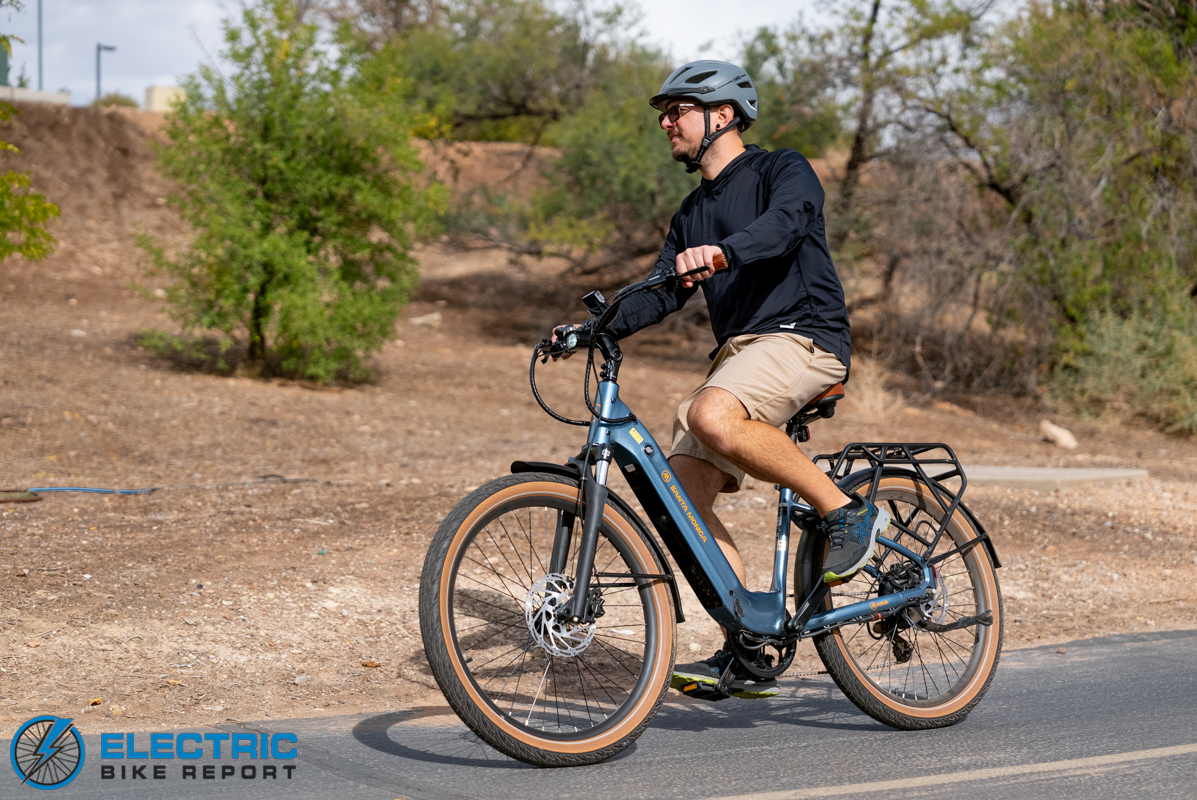
The upright riding position keeps the ride relaxed and comfortable, even across many miles.

An 8-speed Shimano Altus drivetrain offers a well-matched gearing range for the Santa Monica’s Class 3 speed capability.
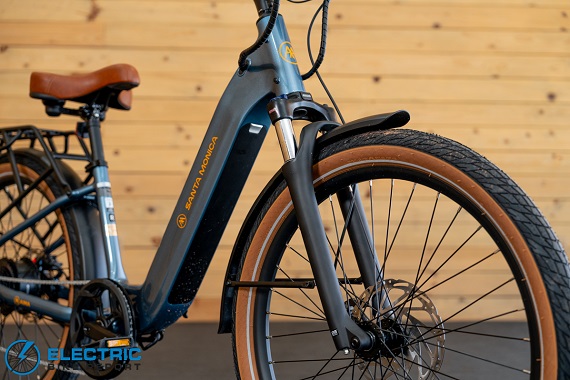
The bike’s 720-Wh battery is concealed within the down tube, but also removable for easy charging.
AIMA Santa Monica Review: Range Test
AIMA’s website states that the Santa Monica can realistically achieve 30-60 miles of range with a single charge of its 720 watt-hour (Wh) battery. To test this claim, we rode the bike in PAS 1 and PAS 5 until its power pack was empty; our results of 55.5 and 31.7 miles largely supported the brand’s advertised range.
We were pleased to note that the bike also fell in line with the performance of many of its peers. Similar commuter and cruiser-style e-bikes we’ve tested averaged 60.4 and 32.7 miles in their low- and high-power range tests, respectively, showing a difference of only 1-5 miles.
The Santa Monica’s results in this test were admirable, but even more impressive when considering that its motor is more powerful than most similar models we’ve tested.
For reference, the group of comparison bikes featured drive units that averaged around 590W in nominal output; these motors used roughly 10.9 and 19.8 watt-hours per mile (Wh/mi) in their low and high-power tests, respectively. The Santa Monica’s 750W motor used 13 and 22.7 Wh/mi.
There was also a noticeable difference in battery capacity between the Santa Monica and its peers; AIMA outfitted its cruiser with a 720 Wh battery, while those of similar models we tested averaged roughly 635 Wh. With these factors in mind, the Santa Monica’s larger-than-average battery helped fuel its more powerful-than-average motor, making it possible for the bike to travel similar distances.
Considering that the Santa Monica is capable and enjoyable to ride even in its lowest PAS level, we feel most riders should expect to land somewhere between our results—perhaps even more toward the high end.
Most riders we interact with tend to take round trips up to roughly 20 miles. As such, we consider the Santa Monica appropriately-specced and capable of meeting the needs of those who use the bike for leisure, exercise, or daily travel to work/school.
When recharging is necessary, the bike’s included 3A charger can refill its battery in roughly 5 hours.
AIMA Santa Monica Review: Hill Test
As mentioned in the introduction to this review, the AIMA Santa Monica proved to be one of the best performers of its style that we’ve tested. At our official test location, the bike scored a 1:54 throttle result and a 1:49 time when pedaling. For comparison, similar e-bikes, including some of the best electric cruisers, averaged 2:13 and 2:10, respectively.
Once again, the Santa Monica’s results are excellent on their own, but they are even more impressive when put in context. As mentioned previously, its motor is more powerful when compared to similar models we’ve tested, but it is also on the heavier side for a bike in the cruiser/commuter category, which makes it more difficult to move uphill.
The bike weighs just over 70 lbs and its 750W motor, which peaks at 1260W, can produce 70 Newton-meters (Nm) of torque. The e-bikes used for comparison averaged roughly 64 lbs with motors that peaked at 919W and were capable of 75 Nm of torque. For further context, the Santa Monica’s peak wattage puts it as the second most powerful cruiser/commuter we’ve tested at the Devil’s Backbone (at the time of writing).
Its motor’s higher peak clearly paid off; the bike finished our Hill Test 19-21 seconds faster, on average, than its peers.
My personal experience riding the Santa Monica reinforced both the bike’s impressive Hill Test numbers and its results in our Speed Test (see above); its lowest assist level delivered a surprisingly pleasant and effective amount of pep, while its highest assist level made short work of even some relatively intimidating climbs.
Additionally, the bike can effectively conquer hills with both its throttle and pedal assist system, giving riders the ability to choose how (and how easily) they want to tackle uphill travel.

AIMA offers the Santa Monica in Black, White, and the eye-catching Blue of our test bike.
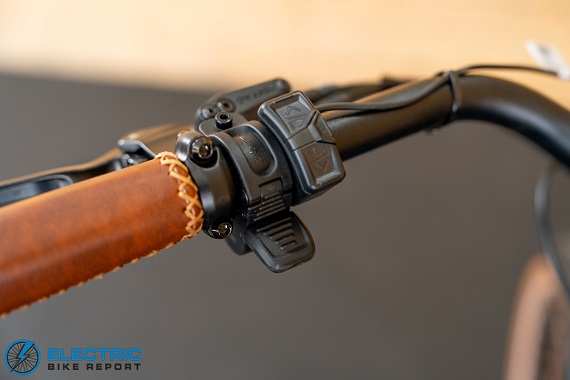
The left-hand thumb throttle and simple control panel are within easy reach of the left faux leather grip.
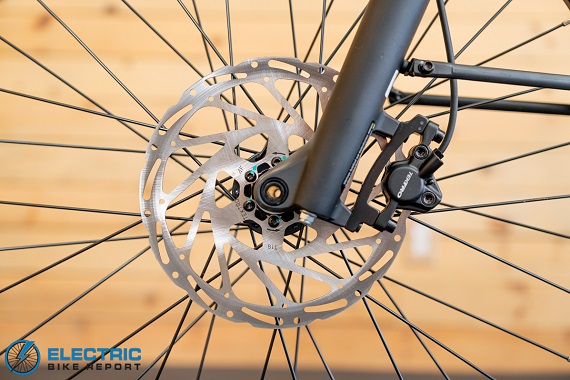
While we often see the Santa Monica’s brake system paired with 180mm rotors, AIMA opted for upgraded 203mm rotors.
AIMA Santa Monica Review: Brake Test

Using our standard testing method, the Santa Monica’s final score in our Brake Test was 21 feet, 8 inches, which places it just slightly above average in comparison to similar models we’ve tested. That group of e-bikes average a stopping distance of 21’11” in this test.
For a third time, the bike’s test result looks even more impressive with deeper analysis.
AIMA equipped the Santa Monica with a familiar e-bike-specific brake model: Tektro’s HD-E3520 2-piston hydraulic disc system. While relatively entry-level, our previous experiences with this model have proven their effectiveness. E-bikes equipped with these brakes are typically in the relatively average range of results with safe, strong performance.
As I mentioned previously, the Santa Monica is somewhat heavier than average for a hybrid cruiser/commuter e-bike; this extra weight makes it more difficult to slow down. AIMA compensated for this factor by giving the bike larger-than-average 203mm rotors, which are more effective at heat dissipation than the more common 180mm rotors paired with the E3520 system.
Based on their feel alone, I’d have guessed the Santa Monica’s Brake Test score would have been even better; the brakes responded well with good bite and modulation. They felt forceful but not too aggressive, making every application of the brakes feel safe and controlled.
With personal experience and a shorter-than-average stopping distance in our formal test proving its brake system’s effectiveness, the Santa Monica gets our stamp of approval yet again!
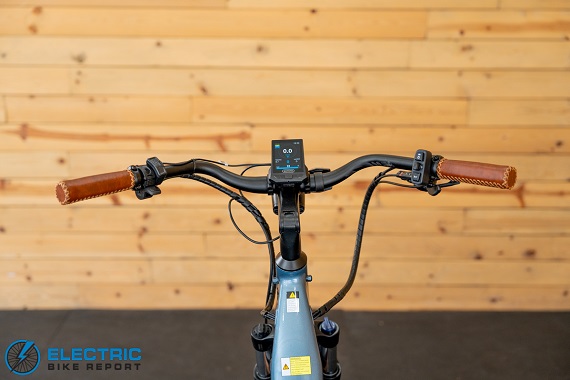
The bike’s cruiser-style handlebars are relaxed while still offering good steering control.

A bright LED headlight illuminates the path ahead when riding before the sun comes up or after it goes down.
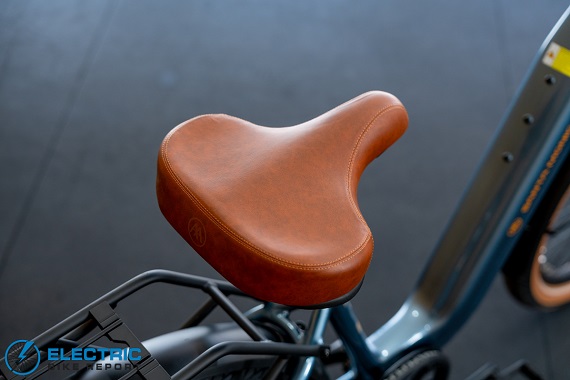
We liked the pairing of the Santa Monica’s brown saddle and grips and its classic-looking tan-wall tires.

A set of 27.5×2.6” tires keep the bike planted and the ride cushioned and stable.
AIMA Santa Monica Review: Ride Quality
Continuing our strong overall experience with the Santa Monica, ride quality is an area where the bike excelled. Its look and feel are fitting for an e-bike in the cruiser category. As I touched on in the introduction, it is both comfortable and well-equipped, making long rides and daily use practical and enjoyable.
AIMA offers the bike in two frame sizes: the Regular is intended for riders from 5’1” to 5’10”, while the Large is intended for those between 5’6” and 6’3”. At 5’11”, I was technically just above the recommended range for our smaller-size test bike, but it adapted quite well to my fit and comfort preferences—largely thanks to the bike’s seatpost and adjustable stem.
With over 6 inches of saddle height adjustment and 80 degrees of rotation in the stem, riders within the recommended range should be able to get decent leg extension and set the handlebar height and reach at a comfortable position. With the saddle at its highest position, I didn’t quite reach full leg extension, but the sensitivity of the PAS and the powerful motor made this a non-issue.
The ride was made comfortable by a combination of factors. These included the bike’s fit, its contact points (a thick, wide spring saddle and hexagonal ergonomic rubber grips), its 75-mm travel SR Suntour suspension fork, and its 2.6” wide tires. The combination of elements resulted in an ergonomic, upright riding position with plenty of shock absorption.
As is common with many e-bikes of its style, the Santa Monica is predictable and relatively relaxed in its handling, making it appropriate for both casual cruising and daily commuting. The frame’s sub-16” standover height makes getting on and off the bike easy, and while I did feel some frame flex when maneuvering, the bike felt sturdier than most with a step-thru design.
I appreciated the bike’s package of useful and user-friendly features. As one might expect for a commuter-friendly ride, the Santa Monica has integrated lights, fenders, and a cargo rack, but AIMA added some thoughtful extras and upgrades.
For example, the bike’s cargo rack, which can carry an impressive 59.5 lbs, is MIK-HD-compatible. This feature makes it able to be equipped with a range of optional accessories that lock into place, including cargo baskets, storage bags, pet carriers, and even a child seat.
Additionally, the bike’s tail lights include turn signals operated by a toggle switch on a module mounted to the right handlebar. This module, which activates a helpful alarm when the signals are on (so you don’t forget to turn them off), also includes a push-button toggle for the lights and an unmissable (some might say relatively ear-splitting) electronic horn.
The bike’s user interface is also a highlight due to its overall simplicity. While I appreciate e-bikes with many customization options and robust apps, I understand that some riders prefer less complex products. The Santa Monica is simple and straightforward, with the ability to activate a security PIN upon startup being one of its most elaborate options.
Overall, the Santa Monica is simply a nice bike, with my initial impression of its classic-inspired appearance carrying through to its user-friendly operation and overall comfort level.
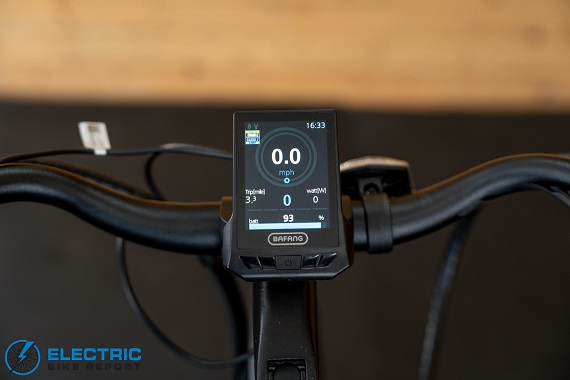
The Bafang color display offers three design themes and well-presented ride data.
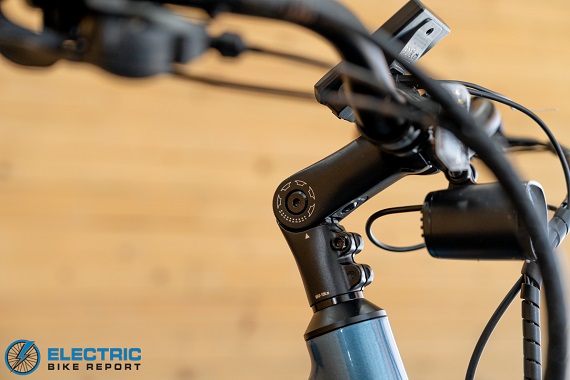
An adjustable stem allows riders to find a comfortable handlebar height and reach distance.

AIMA equipped the Santa Monica with an MIK-HD cargo rack that is compatible with many third-party accessories.

Integrated turn signals are always an appreciated feature on a bike likely to share the road with automobiles.
AIMA Santa Monica Review: Summary / Where to Buy
It’s always a good sign when I find myself struggling to find an e-bike’s downsides; the AIMA Santa Monica was appealing, enjoyable, and impressive from the start of my time on the bike to the finish. Between its looks, ride feel, and overall performance, it’s remarkably easy to say that the Santa Monica is a fantastic bike.
For the record, this is coming from someone who doesn’t gravitate naturally toward cruisers; as a professional reviewer, I can appreciate what they offer for those who enjoy them, but as an individual, I typically prefer e-bikes with a more sporty and aggressive feel.
The bike’s test results speak for themselves. In our Speed Test, it proved responsive and adaptable with intuitive programming. In our Range Test, it largely matched its peers in providing practical mileage for daily use. The Santa Monica’s Hill Test times were flat-out excellent, and it even topped the average in our Brake Test with great stopping power.
Our only real point of critique is that any modifications to the bike’s speed must be done in-person by a technician at one of AIMA’s brick-and-mortar dealerships. For those who live far away from a bike shop or who wish to revert to default settings after setting their speed higher, this could present a challenge.
Otherwise, I’m thrilled to have had such a great first experience with AIMA; the brand’s popularity among our readers/viewers seems well-deserved.
In addition to feeling like I could confidently recommend the Santa Monica to my own comfort-oriented friends or aging family members, the bike’s strengths make it a shoe-in for fans of the cruiser style who want a responsive, highly capable leisure bike—and possibly even those who don’t know they’re cruiser enthusiasts yet!
Furthermore, the Santa Monica would be an excellent choice for riders in hilly areas, those seeking a relatively uncomplicated and low-tech experience, and folks who want a fun, active, and classy-looking way of getting to and from the office.
Happy Riding! Make sure to let us know if you have any questions or if you think we left anything out in this review of the AIMA Santa Monica down in our comments section.




Leave a Reply